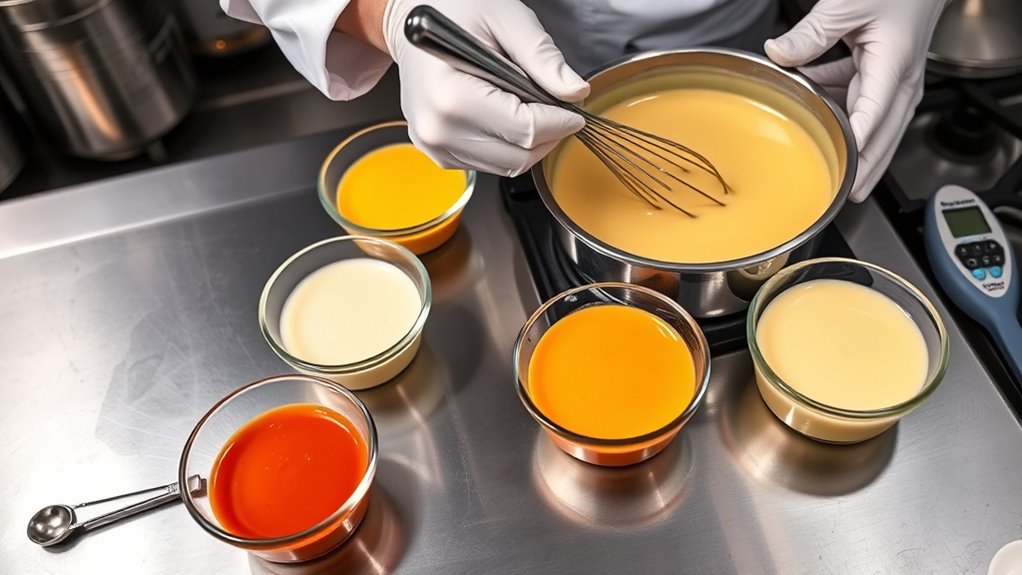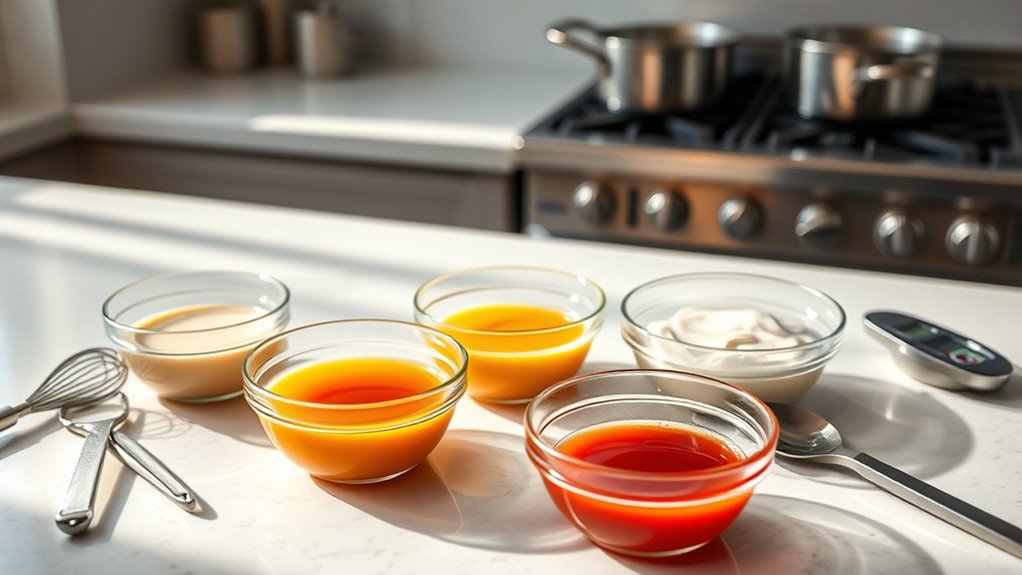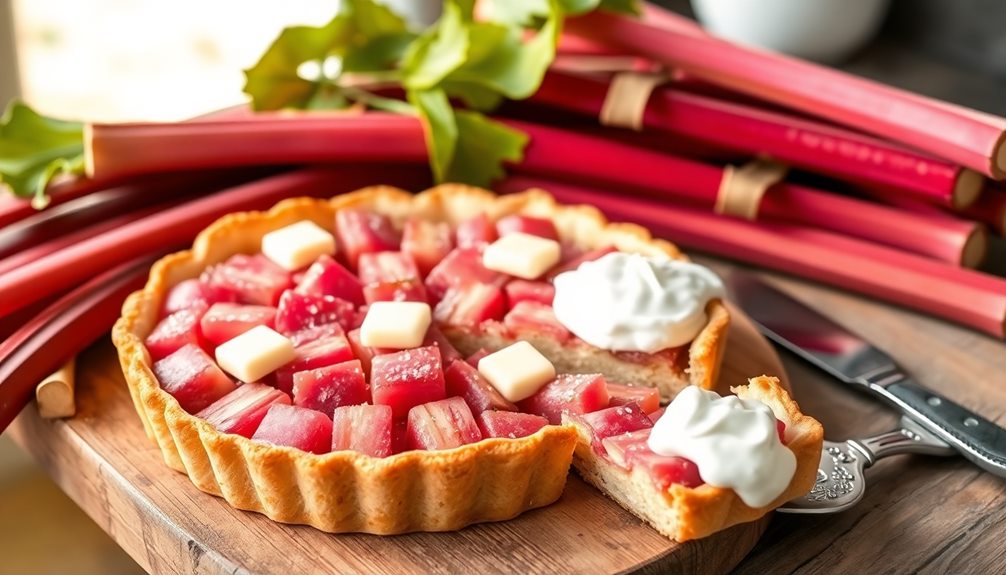Crafting French mother sauces involves understanding their unique chemistry and mastering techniques to control consistency. You start by carefully simmering and whisking ingredients to achieve smooth textures, adjusting heat to prevent separation. If sauces are too thick, thin them with broth or milk; if too thin, simmer longer or add roux. Managing ingredients skillfully and making proper adjustments will help you create rich, velvety sauces. Keep exploring, and you’ll discover how to perfect each sauce step by step.
Key Takeaways
- Understanding the unique textures and compositions of each mother sauce guides proper preparation and consistency control.
- Precise simmering and whisking techniques are essential to achieve smooth, velvety, or rich sauce textures.
- Ingredient substitutions and adjustments can tailor flavors and accommodate dietary or resource constraints effectively.
- Controlling heat and using thickeners or diluents allows for on-the-spot consistency corrections.
- Mastering these steps involves chemistry principles like emulsification, reduction, and thickening to craft authentic sauces.

Have you ever wondered what makes many classic dishes so versatile and flavorful? It all comes down to mastering the French mother sauces, the foundational building blocks of countless recipes. When you’re working with these sauces, understanding their sauce consistency is key. Each mother sauce has a distinct texture—some are smooth and velvety, like béchamel, while others are richer and more substantial, like espagnole. Achieving the perfect sauce consistency often requires careful simmering and whisking, as well as adjusting the heat to prevent clumping or separation. If your sauce turns out too thick, you can thin it with a splash of broth, milk, or water, depending on the sauce type. Conversely, if it’s too thin, simmer longer to let it reduce or incorporate a bit of roux or butter to thicken it up. This control over sauce consistency is crucial because it affects how the sauce coats and complements your dish, elevating simple ingredients into something extraordinary. Consistent texture is essential for a professional finish and optimal flavor distribution. Ingredient substitutions are also a vital part of working with these sauces. Sometimes, you might not have a specific ingredient on hand, or you want to tailor the flavor to suit your preferences or dietary needs. For example, if you’re making béchamel but run out of butter, you can substitute margarine or even olive oil for a different richness profile. Similarly, if traditional veal stock isn’t available for espagnole, a good-quality chicken or vegetable stock can work as a suitable alternative. When it comes to thickening agents, flour is standard, but cornstarch or arrowroot can be used in a pinch for gluten-free options. You can also experiment with herbs, spices, or aromatics to add your personal touch or adapt the sauce to different cuisines. Incorporating techniques for adjusting sauce consistency enables you to better control the final texture and flavor balance. Being aware of Ingredient substitutions is also important, as it allows you to be resourceful and flexible in your kitchen. For example, understanding how drainage and storage affect the shelf life and performance of ingredients helps you make better substitutions and store your ingredients properly. These substitutions and techniques help you develop a deeper understanding of how ingredients interact and how to manipulate the sauce’s texture and flavor. Understanding how to adjust sauce consistency and make ingredient substitutions empowers you to become more confident in your cooking. It’s not just about following a recipe blindly but about developing a sense of how the ingredients interact and how to manipulate the sauce’s texture and flavor. This knowledge guarantees you can troubleshoot and adapt on the fly, whether you’re thickening a velvety béchamel or thinning a tomato-based espagnole. By mastering these techniques, you’ll open the full potential of the French mother sauces, transforming humble ingredients into elegant, flavorful dishes with confidence and creativity.
Frequently Asked Questions
What Tools Are Essential for Making Mother Sauces?
To make mother sauces, you need essential tools like a good whisk and a sturdy saucepan for sauce thickening and flavor balancing. A slotted spoon helps with stirring without breaking ingredients, while a fine-mesh sieve ensures smooth textures. Measuring cups and spoons help maintain consistency. With these tools, you can control the sauce’s thickness and flavor, making your sauces perfectly balanced and delicious every time.
How Long Can You Store Homemade Mother Sauces Safely?
You can store homemade mother sauces safely in the refrigerator for up to four to five days. Proper storage duration is essential for refrigeration safety, so always keep your sauces in airtight containers and label them with the date. If you need to store them longer, consider freezing, but be aware that this might impact the sauce’s texture and flavor. Always reheat thoroughly before serving to ensure safety.
Can Mother Sauces Be Made Vegetarian or Vegan?
Imagine transforming a classic French mother sauce into a vibrant, plant-based masterpiece! You can definitely make mother sauces vegetarian or vegan by substituting dairy with plant-based milks or nut creams, and using vegan thickeners like cornstarch or arrowroot. This way, you preserve the sauce’s rich texture and flavor while respecting your dietary choices. With a little creativity, you can craft delicious, entirely plant-based sauces that impress everyone.
What Are Common Mistakes to Avoid When Preparing These Sauces?
When preparing French mother sauces, avoid over-seasoning, which can overpower the delicate flavors, and improper storage techniques that can spoil your sauces quickly. Always taste as you go to prevent over-seasoning mistakes, and store sauces in airtight containers, keeping them refrigerated to maintain freshness. Paying attention to these details guarantees your sauces stay balanced and safe to enjoy, elevating your culinary skills with confidence.
How Do You Customize Mother Sauces for Different Dishes?
Ever wondered how to make a mother sauce suit your dish better? You can customize it through flavor variations and ingredient substitutions, tailoring the sauce to your taste or cuisine. Add herbs, spices, or even swap cream for broth to create a new profile. This flexibility lets you elevate your cooking and make each dish unique, showcasing your personal touch while respecting the classic foundation.
Conclusion
By mastering these French mother sauces, you unseal a world of culinary possibilities. Did you know that these five base sauces serve as the foundation for over 1,000 derivative recipes? So, next time you cook, remember that understanding their chemistry not only enhances your skills but also opens up endless creative options in the kitchen. Keep experimenting, and you’ll transform simple ingredients into gourmet masterpieces with confidence.










